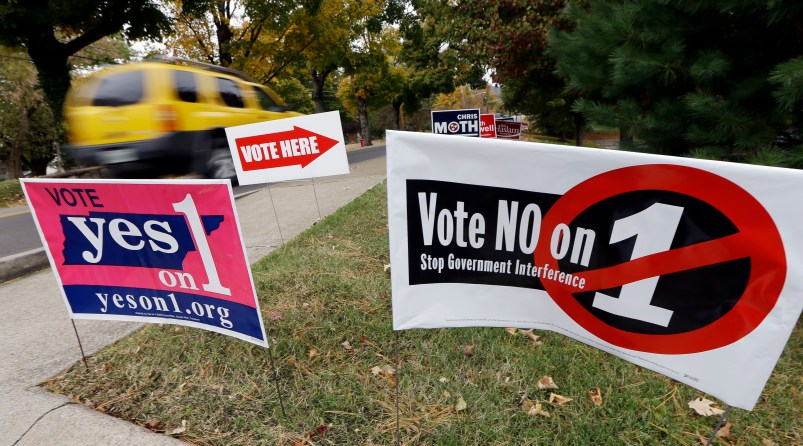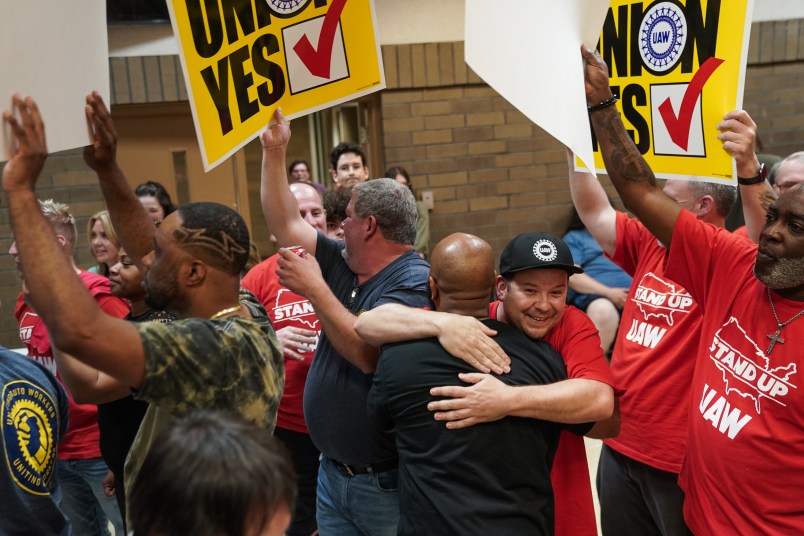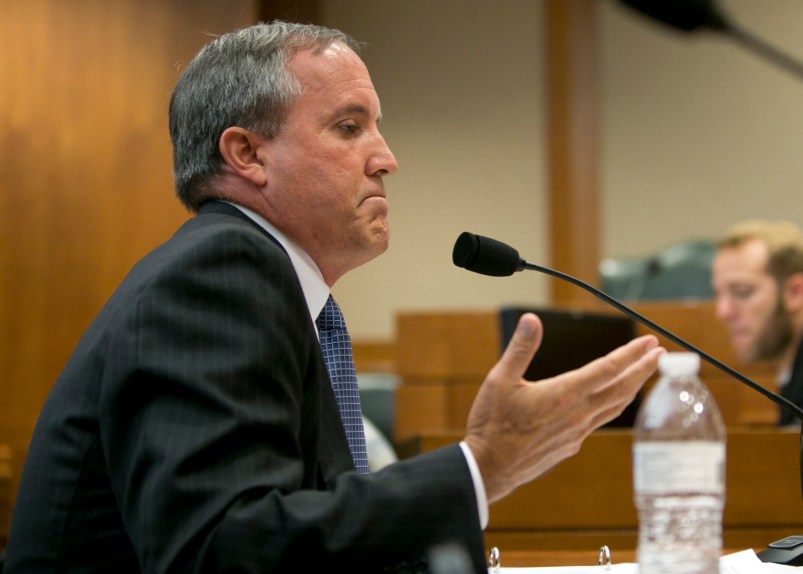The midterm elections are over and now we are looking at a political landscape where voters have shown that for the moment they prefer conservatives in office, but at the same time want progressive policies enacted in their states. Ballot initiatives such as raising the minimum wage, implementing paid sick leave and extended background checks for gun owners all passed when put up for a popular vote.
Even when it came to abortion rights in a hostile midterm, statewide votes were more often successful than not. Two state votes on “personhood” amendments, which would have had the ability to potentially ban all abortions and even some forms of birth control, failed to pass in North Dakota and Colorado, each with two to 1 margins.. [A more limited anti-abortion measure in Tennessee managed to win, with yes votes outnumbering no votes 53 percent to 47. Out of a total of 3.5 million votes cast on anti-abortion ballot measures across three states this election, over 2 million voters rejected these amendments
Ballot amendments also appeared to have helped defeat some anti-abortion candidates in Colorado and North Dakota, too. While Democratic Senator Mark Udall lost his reelection bid as part of the Republican wave, Democratic Governor John Hickenlooper managed to fend off a challenger in a race that was either tied or showed him trailing leading up to election day – a surprise so unexpected that Hickenlooper actually conceded the race earlier in the evening before the results changed in his favor. The result replicated those in 2010, when “personhood” also was on the ballot and appeared to have helped Hikenlooper and other Dems win despite a Republican wave across the rest of the country.
In North Dakota, two of the most extreme anti-abortion politicians – state Rep. Bette Grande (R-Fargo) and state Sen. Margaret Sitte (R-Bismarck) both lost their reelection campaigns. Sitte was the amendment’s sponsor in the state Senate, and introduced the measure as a chance for the state to try to overturn Roe v. Wade (later in the campaign she said that was no longer the measure’s intent). Grande was the sponsor of the state’s currently blocked “heartbeat” ban, among other abortion restrictions. The voters’ rejection of both these candidates on Election Day makes it clear that North Dakotans are done with lawmakers who are obsessed with abortion restrictions.
That’s a message the North Dakota state legislature is actually acknowledging, too. Despite still having a Republican majority in the state House and Senate, as well as a reliably anti-abortion governor, Republican leaders say that when they begin the 2015 legislative session, they don’t intend to do anything more with abortion.
“Senate Majority Leader Rich Wardner, R-Dickinson, said it appears that the outcome of Tuesday’s election was a message from the North Dakota electorate that it prefers lawmakers deal with more pressing issues facing the newly oil-rich red state, where a population boom has put unprecedented pressure on infrastructure and social services,” reports ABCNews.com. Wardner told the station that he “doesn’t expect any abortion-related legislation to surface during the legislative session,” this time.
In some ways, despite the angst that comes with the possibility of seeing reproductive rights stripped away permanently for an entire population of a state, the most extreme of anti-abortion ballot measures are actually having a positive effect on races. They give a legislature a tangible measure of where their population stands on abortion and birth control access, translating exit polling data like “voters want abortion to remain legal 54 to 42 percent.” When two-thirds of voters reject an abortion amendment on Election Day, it’s a clear indication that continuing to legislate on that issue puts political futures is in trouble.
“Time and again, voters reject these extreme amendments, even in the most conservative states,” said Sarah Stoesz, President of Planned Parenthood Minnesota, North Dakota, South Dakota via email. “Lawmakers around the country should take a page out of North Dakota’s book and stop pushing this agenda.”
If extreme anti-abortion ballot measures are actually serving to not only prove to lawmakers how popular legal abortion rights remain, but warn them not to try to attempt new bans, does it make sense to consider proposing our own on the pro-choice side? That’s a recommendation that Ilyse Hogue, President of NARAL Pro-Choice America made as part of her post-election analysis.
“Ballot measures, the most accurate measure of voter sentiment, provide even clearer evidence of the rejection of the anti-choice mentality,” wrote Hogue for RH Reality Check, who then suggested drafting out own measures for upcoming cycles. “When our values are put directly to the voters, we win. Yet we’ve been playing defense on ballot measures almost exclusively. If we care about not only protecting but expanding reproductive freedom in this country, let’s take our case directly to the voters, state by state, to bolster women’s reproductive freedom.”
Pro-choice activists putting forth their own ballot measures has a number of advantages for those who support access to abortion and birth control. First, it allows them to craft the message to be a win for reproductive rights if it goes through, and not hurt the cause too badly if it doesn’t. The process of getting a measure to the voters on Election Day also usually requires petitions or some other campaign, giving reproductive rights activists not only the chance to talk one-on-one with potential voters about why protecting these rights is good, but also gather the names and contact information to those supportive of the cause.
And, as Personhood USA has admitted very frankly in the last election, making the opposition battle you on a measure means making them use up precious resources such as money and manpower. One day after the election, the Colorado-based anti-abortion group characterized their massive defeat in Colorado as a win, since it forced abortion rights supporters to spend massive amounts of money just to maintain the status quo.
“Personhood USA and A Voice for Brady were outspent by about 1,300 to 1, yet more than 650,000 voters affirmed personhood for the unborn—a record number for any total abortion ban ever,” wrote Josh Craddock. “Planned Parenthood promised to spend least $3.8 million to defeat Amendment 67 in Colorado, yet they lost ground at the polls to a ‘YES on 67’ campaign that—according to the Colorado Secretary of State—only spent a reported $29,000.”
He added, “The obscene amount of money Planned Parenthood spent to defeat Amendment 67 will have crippling effects on their abortion business in the state.”
If there was ever a time to move on statewide ballot amendments, this would be the year. With even more state legislatures moving into full Republican control — some even amassing veto-proof majorities — abortion bans and restrictions haven’t already been passed are likely to be introduced as soon as the 2015 session starts. Ballot amendments of our own would serve as a reminder that, regardless of what the politicians themselves want when it comes to abortion, most of their constituents feel abortion should be legal and accessible under most cases.
Simple ballot measures, such as allowing Medicaid to cover abortions for the poorest of the state’s residents, affirming that all people have the right to birth control, or explicitly stating that the state constitution offers the same right to an abortion that the federal constitution does, should all considered during the upcoming months.
The majority of Americans support legal abortion. Now is the time to remind our lawmakers that they need to legislate that way, regardless of their majorities.
Robin Marty is a freelance writer, speaker and activist. Her current project, Clinic Stories, focuses on telling the history of legal abortion one clinic at a time. Robin’s articles have appeared at Slate, Cosmopolitan.com, Rolling Stone, Ms. Magazine and other publications.









